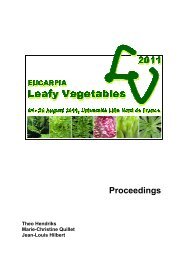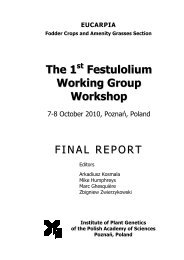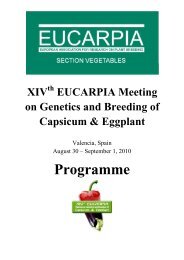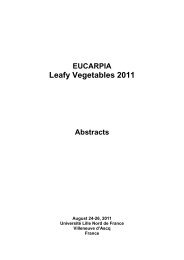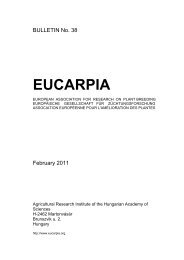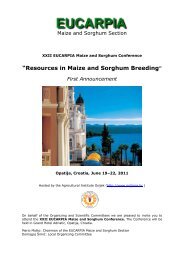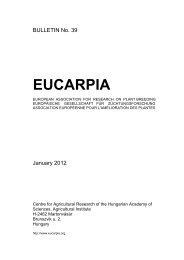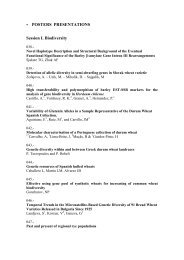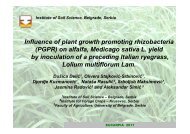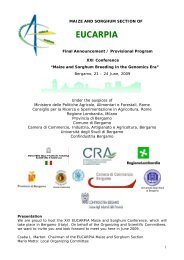Plant breeding for organic and sustainable, low-input agriculture
Plant breeding for organic and sustainable, low-input agriculture
Plant breeding for organic and sustainable, low-input agriculture
Create successful ePaper yourself
Turn your PDF publications into a flip-book with our unique Google optimized e-Paper software.
Breeding <strong>for</strong> <strong>organic</strong> <strong>agriculture</strong> – Strategy <strong>and</strong> example in practice<br />
Franziska Löschenberger<br />
Saatzucht Donau GmbH&CoKG (SZD), Probstdorf, Austria<br />
Breeding <strong>for</strong> <strong>organic</strong> <strong>agriculture</strong> (BFOA) takes advantage of the fact that the expression of many<br />
traits is highly correlated between conventional <strong>agriculture</strong> (CA) <strong>and</strong> <strong>organic</strong> <strong>agriculture</strong> (OA)<br />
(Baresel, 2006; Ober<strong>for</strong>ster 2000 & 2006). Low <strong>input</strong> CA with limited nitrogen supply <strong>and</strong><br />
without the application of fungicides leads to yield levels comparable to OA. Selection in CA<br />
can be a useful step <strong>for</strong> a preliminary selection <strong>for</strong> OA (<strong>and</strong> can thus be regarded as indirect<br />
selection <strong>for</strong> OA). Tillering capacity, early vigorous growth, earliness (heading date), disease<br />
resistance, culm length, spike- <strong>and</strong> other morphological <strong>and</strong> grain characteristics, like thous<strong>and</strong><br />
kernel weight (TKW), <strong>and</strong> protein quality are examples <strong>for</strong> highly heritable traits – <strong>for</strong> which<br />
indirect selection is most promising.<br />
BFOA in winter wheat: Variability is created by including material especially adapted to OA into<br />
the crossing program. Selection starts in F3 on single plants on a conventional field. Single ears<br />
are cut from selected plants <strong>and</strong> continued as F3-derived lines. At this stage, in F4, the most<br />
important selection occurs by means of scores <strong>and</strong> measurements <strong>for</strong> highly heritable<br />
morphological, agronomic, resistance <strong>and</strong> quality traits. In F5:3, the lines are grown on three<br />
locations <strong>for</strong> observation. Yield potential is estimated by harvesting only one location, several<br />
parameters of quality are being analysed. Analysing visual scores, yield <strong>and</strong> quality data, the<br />
genotypes are then divided into lines fitting solely <strong>for</strong> CA <strong>and</strong> material better adapted to OA. The<br />
first yield trial is grown parallel under <strong>organic</strong> <strong>and</strong> conventional conditions <strong>for</strong> most genotypes.<br />
According to the results, genotypes can be switched from the conventional to the <strong>organic</strong> route<br />
<strong>and</strong> vice versa. The advantage of this shuttle-strategy in BFOA lies in exploiting the larger<br />
genetic variance of both the <strong>organic</strong> <strong>and</strong> the conventional genepool that can be exploited in<br />
selection <strong>for</strong> OA.<br />
An alternative route is fol<strong>low</strong>ed by growing F2 to F5 as a bulk on <strong>organic</strong> fields, each year<br />
per<strong>for</strong>ming mass selection of spikes <strong>and</strong> rebulking them. Lines are derived as ear- rows, further<br />
selected as above mentioned “indirectly” <strong>for</strong> 2 years on the conventional fields <strong>and</strong> then again<br />
yield tested on <strong>organic</strong> fields.<br />
Usually in Austria, the varieties released <strong>for</strong> OA are tested <strong>for</strong> 5-6 years at minimum under<br />
<strong>organic</strong> conditions: 2-3 years be<strong>for</strong>e application, <strong>and</strong> 3 years in official <strong>organic</strong> VCU testing.<br />
Up to now, six winter wheat varieties have passed the <strong>organic</strong> VCU test in Austria: Aurolus,<br />
Bitop, Eriwan, Indigo, Pireneo <strong>and</strong> Stefanus. The range of varieties <strong>for</strong> <strong>organic</strong> farming is<br />
variable from speciality varieties with specific adaptation <strong>and</strong>/or special quality characteristics to<br />
broadly adapted varieties. Summarizing the experiences, varieties <strong>for</strong> <strong>organic</strong> <strong>agriculture</strong> should<br />
have a broad range of adaptability <strong>for</strong> different environment conditions – these environments<br />
vary even more in <strong>organic</strong> as compared to conventional production. To be even more successful<br />
in the future, BFOA needs a strong commitment.<br />
47




